New browsers keep coming all the time, but rarely do they challenge the status quo. So, when a browser like the Arc Browser from the Browsing Company comes along and promises to redefine how we use the web, it's bound to strike more skepticism than trust in your hearts. And yet, Arc Browser will prove its mettle when you give it a chance.
The only hiccup along the way? You'll need to master the steepest learning curve you could imagine when switching to a new browser. You know what? Scratch that. You cannot even imagine it because Arc Browser has long left the path that conventional browsers walk. But once you've braved this learning curve, you're in for a new and better way of browsing the web. And isn't it something?
So, let us be your guides along this (not so) perilous journey on switching to the Arc Browser, and you'll thank us later.
Getting Started
Getting started with the Arc Browser is easy; there won't be any challenges here. In fact, the onboarding process is so fun you'll wish you could do it again and again (or maybe that's just me?).
- Go to arc.net and download Arc (you need macOS 12.1 or later).

- Then, open the downloaded file and install Arc by dropping the icon for Arc to the Applications folder on the opened window.
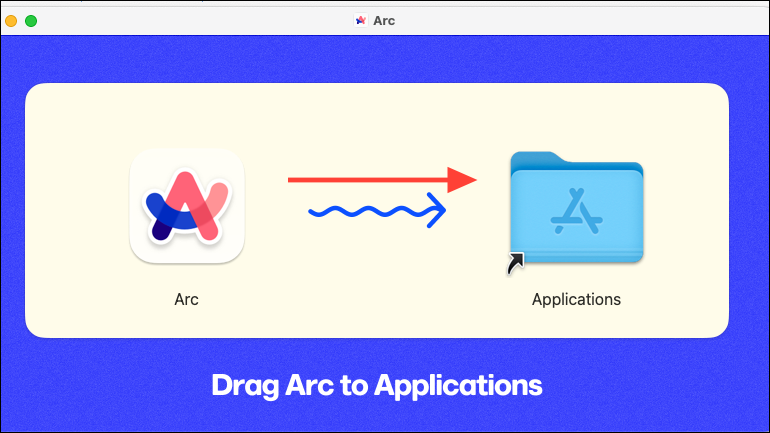
- Arc will be installed and opened. The very first thing you'll need to do is create a free Arc account; this part is non-negotiable as Arc needs an account to sync your data like tabs across Mac, iPhone, or other devices using iCloud.
Enter your name, and email address, create a password, and the account will be created.
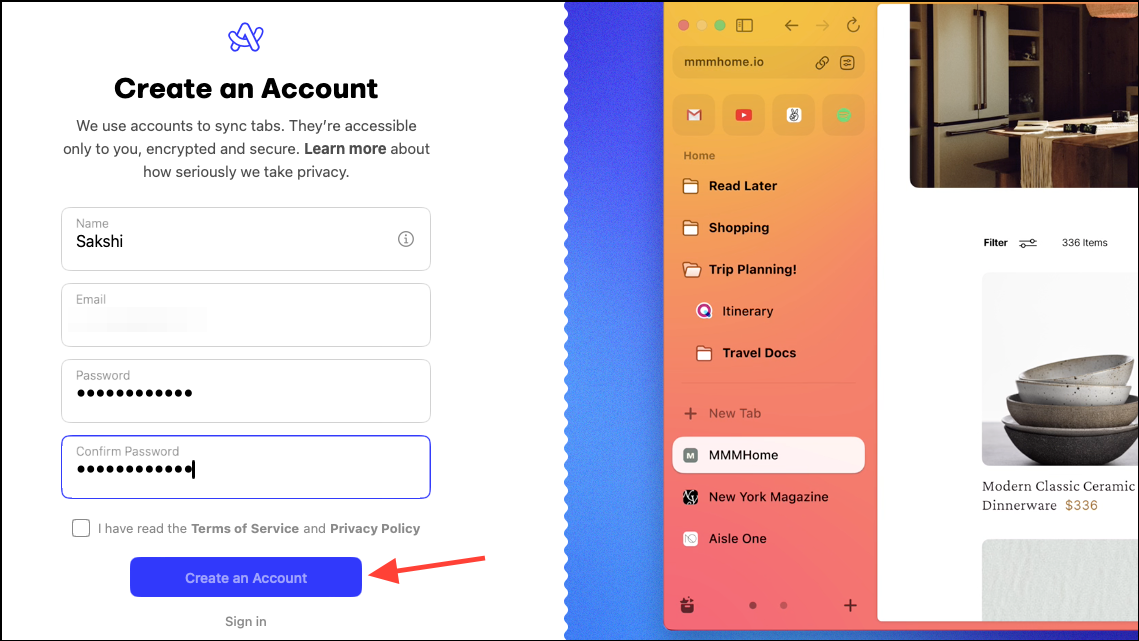
- Then comes the task of setting up the browser, which again is easy enough. This includes going through actions like importing data from your previous browser, setting up a theme, making Arc your default browser, opting to use Arc's ad blocker, adding some favorite apps, etc.
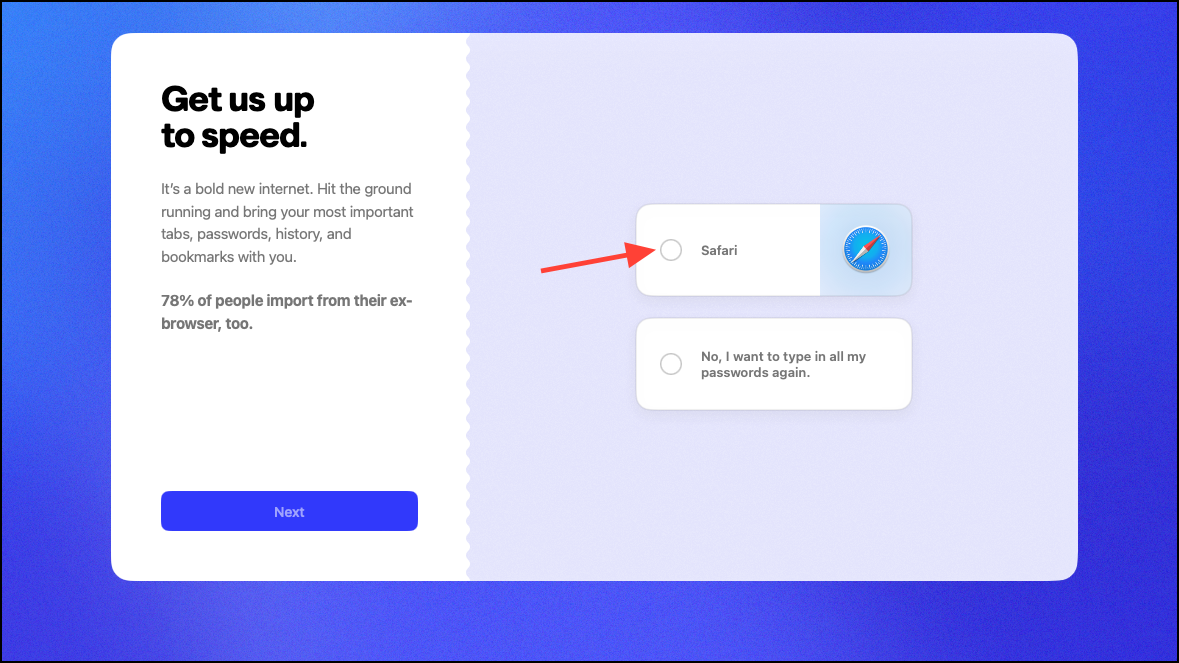
- Follow the instructions on the screen and set up Arc. Then, click on 'Get Started' to finish the setup.
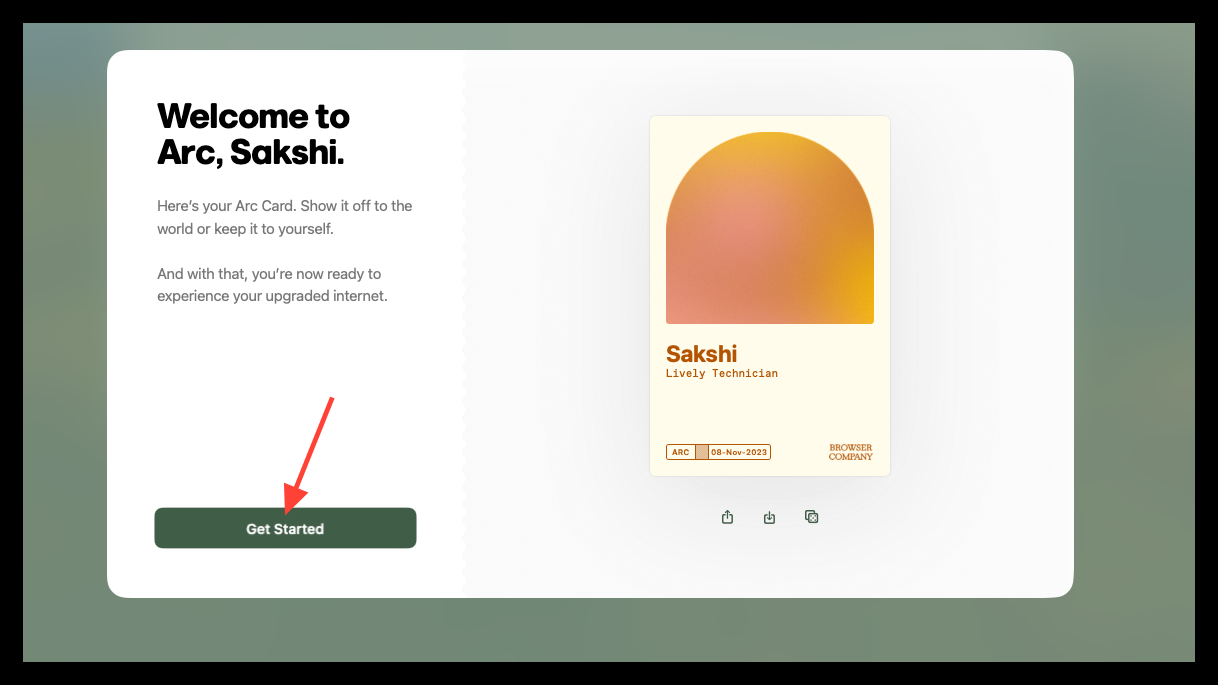
Using Arc
Once Arc is set up, the real job starts. You'll be hit with its drastically different UI as soon as Arc opens up.
1. Sidebar
The sidebar is the first thing you'll need to master to get a handle on Arc. Unlike other browsers that now offer a sidebar, Arc's sidebar is different, much like everything else the browser does.
It features a sidebar that houses most of the controls, from your tabs to the URL bar and navigation buttons, Spaces, Favorites, Library – everything.
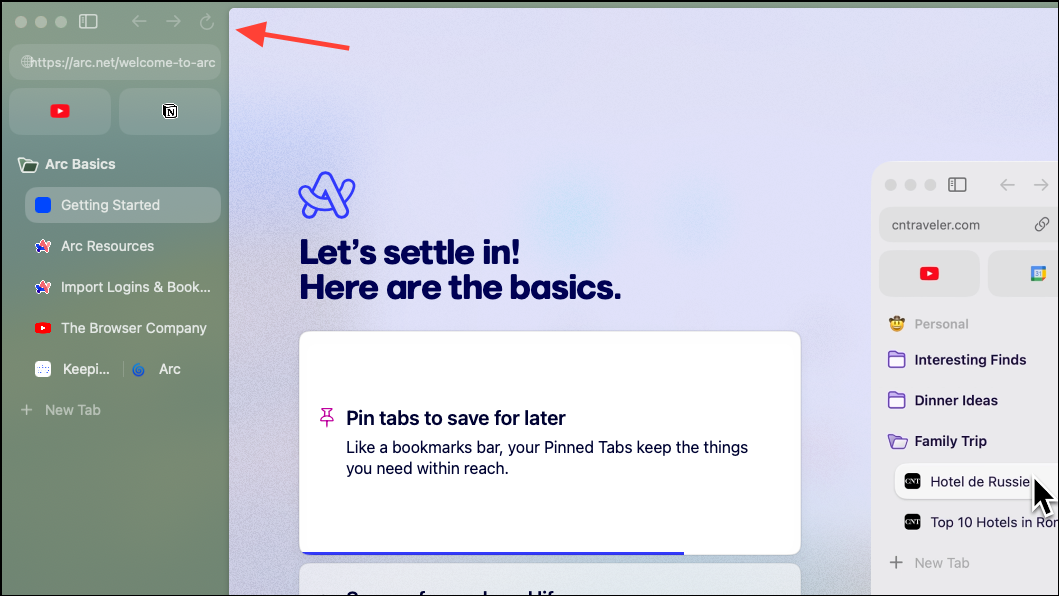
At the top are the navigation buttons – back, forward, and reload. Then, comes the URL bar. The URL bar also has the 'Site Control' icon where you can find more options, like managing site permissions, and extensions, and some Arc-specific options, like creating a boost, taking screenshots, etc.

The sidebar can also be hidden by clicking the 'Sidebar' icon or by using the Cmd + S keyboard shortcut.
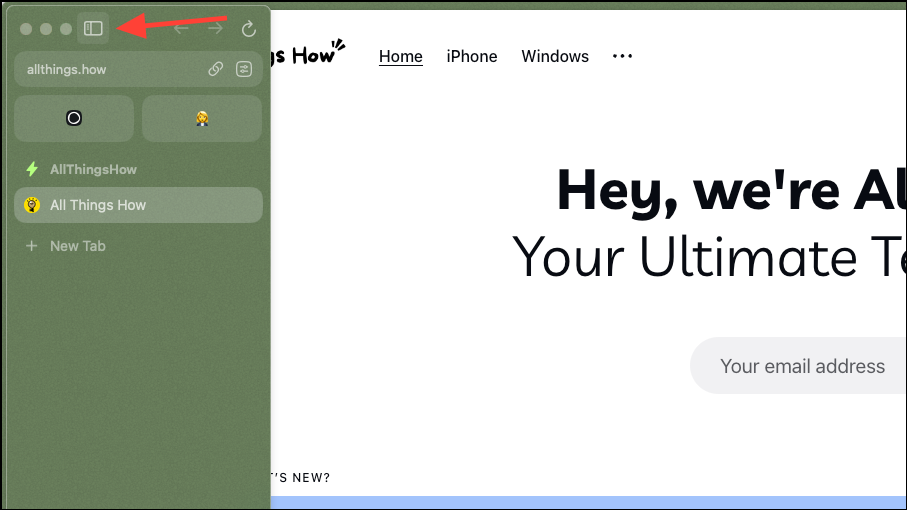
2. Spaces
Arc Browser works with Spaces and creates a default Space when you set up the browser. Spaces are a great way to manage different aspects of your digital life, from work to personal to even having different places for different projects to vacation planning and even something as silly as shopping. You can switch between Spaces from their icons at the bottom of the sidebar.

The best part about Spaces is that they're all accessible within a single window, unlike profiles for most browsers, where switching is nothing short of a hassle.

You can truly separate each Space, with different pinned tabs and themes, to keep your different projects separate. Creating a new Space is easy too. We've discussed them in their entirety in the guide below.

3. Favorites
If you didn't add any apps as favorites during setup, you'll find an empty space up top for them. You should drag and drop your most visited websites here from either pinned tabs or unpinned tabs.
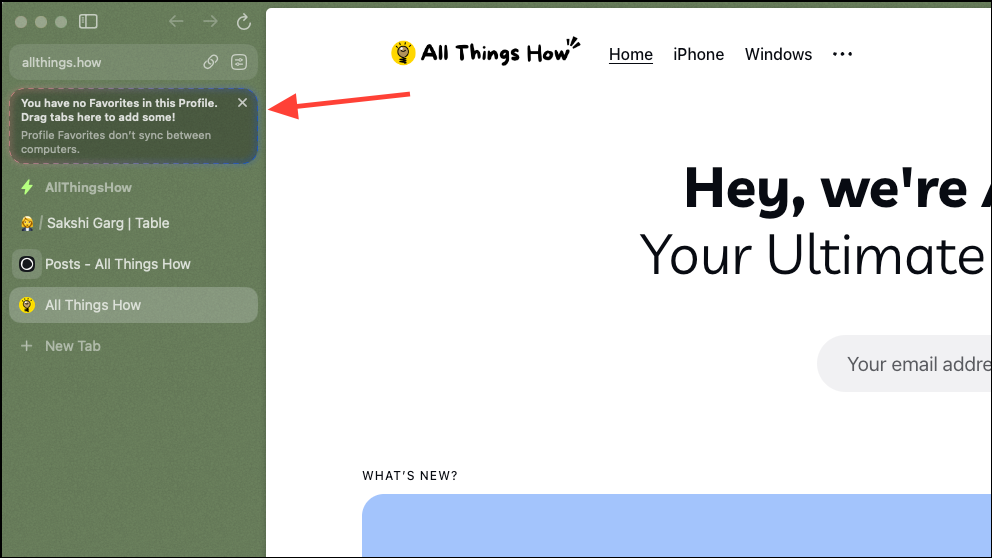
It makes the entire thing feel more like an app launcher. Favorites stay mostly the same throughout different Spaces unless you're using different Profiles.


4. Profiles
With Profiles in Arc, you can have different user accounts for different websites with much ease. But remember that when you use different Profiles, none of the data is imported. You'll need to log in to websites again, and reinstall extensions, among other things. Profiles aren't also synced between different devices currently.
So, while Spaces that are using a separate Profile will appear on another device, they won't have the same Favorites and other configurations that are profile-specific. They'll all be using the Default profile on the other device, and you'll need to recreate your Profiles for that device. I sure do hope that Arc soon implements support for Profile syncing.
You can create a new Profile by right-clicking the sidebar and selecting Profile > New Profile from the context menu. You can find more information about how to use Profiles with Spaces here.
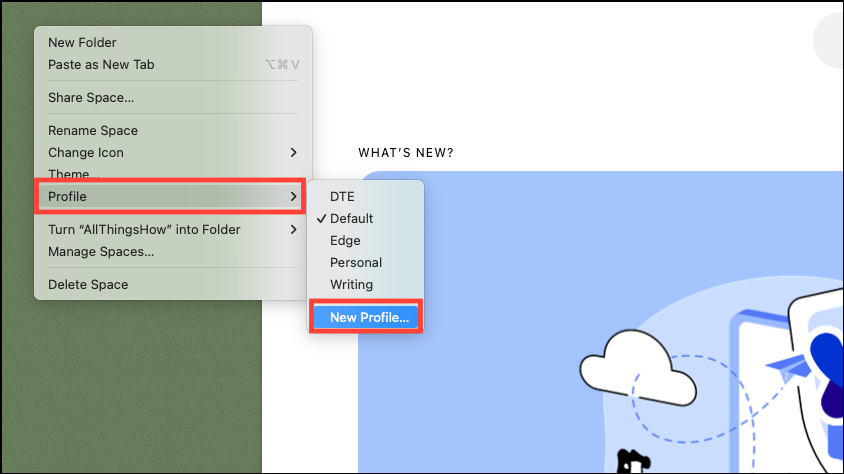
5. Pinned Tabs
Then, comes the section for Pinned tabs. Although, ideally, we should be visiting this section later, you'll find some tabs (getting Started on Arc, etc.) in your Pinned section right away, which is why I'm choosing to address this now.

Arc has a very interesting approach to curing tab overload. It auto-archives tabs after 12 hours (default setting, which can be changed).
- To change this duration, got to
Arc>Settingsfrom the menu bar or use theCmd+,keyboard shortcut.

- Switch to the 'General' tab in the settings window.

- Then, click the option next to 'Archive tabs after' and select a different duration.

Auto-archives is just another word for closing them, and you can find them in your Archived tabs section in the Library (again, another way to say closed tabs) or history (Cmd + Y) that's borrowed from the Chromium engine.
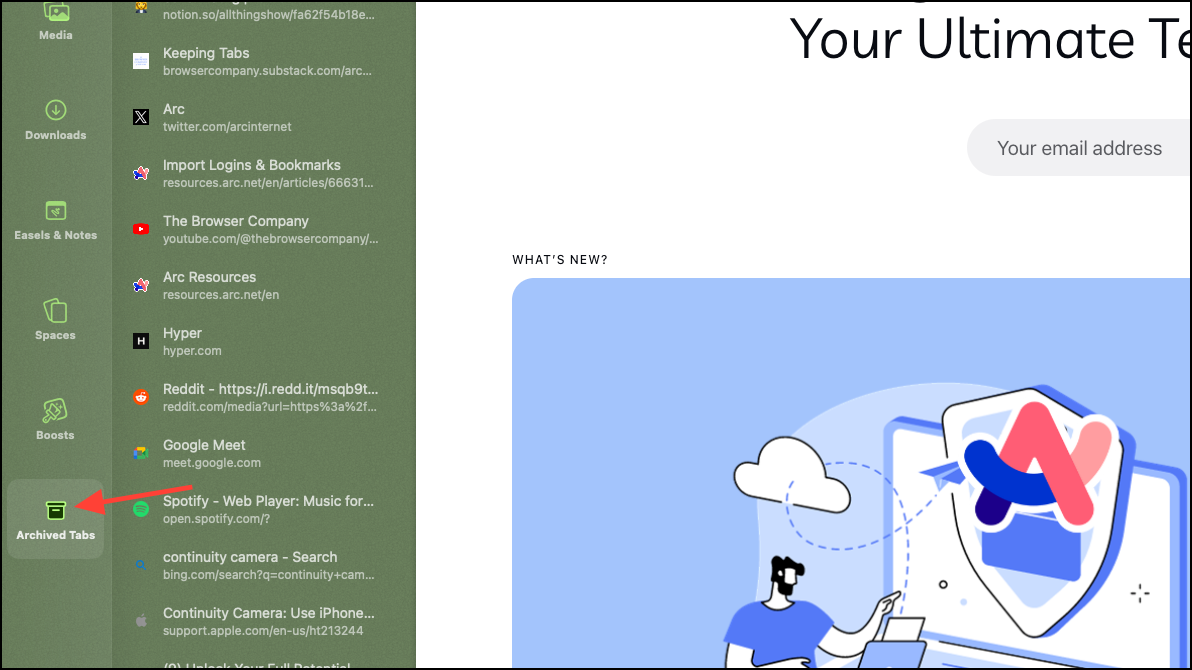
Now, there are always tabs that you'll want to revisit later; that's where the Pinned tabs section comes in. Tabs that you pin are not auto-archived. You can drag and drop tabs from the unpinned section to the pinned section.

6. Opening a New Tab
Now, Arc does not have a home page (it doesn't need one) or a new tab page either. To open a new tab, you can use the keyboard shortcut Command + T. This will open a floating window-like interface, known as the command bar. You can enter a website's URL or any search query here and press enter, and it'll open in a new tab.

7. Command Bar
The command bar cannot just open new tabs. It's a Spotlight-search-like feature that can also serve as your entry point for almost anything in Arc. Whether you need to open settings, switch spaces, go to Arc library, or switch to an open tab, you can do it all from the command bar.
You can see a list of different actions you can perform using the Command Bar by tapping the Tab button from your keyboard when command bar is open.

8. Necessary Shortcuts
You can also switch tabs and Spaces using keyboard shortcuts. In fact, when using Arc, you'll find them to be your best friends. To switch between Spaces, use the Ctrl + [Space Number] keyboard shortcut. To switch between Tabs, use the Cmd + [Tab Number] keyboard shortcut.
Arc also has an in-built Recent Tab switcher, where you can switch between up to 5 of your most recent tabs in a Space using the Ctrl + Tab keyboard shortcut.

9. Folders and Split View
You can also create folders of your tabs to better organize them in the pinned section.
- To create a folder, click the '+' button on the bottom of the sidebar and select 'new Folder' from the options.

- A new folder will appear in the pinned section (that's the only place they can be created); name it and then drag and drop tabs in the folder.
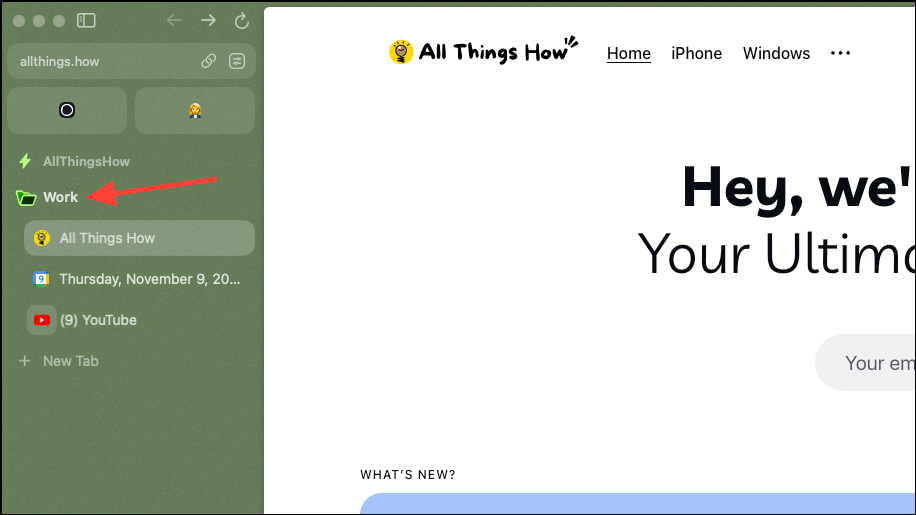
Folders can also be shared now, along with Spaces and Split Views, in a bid to make the internet shareable.

And there are Split Views too. You can open tabs in horizontal as well as vertical split views to open tabs side by side. Arc allows you to open up to 4 tabs in a single Split View.
- To open Split View, click the '+' icon from the sidebar and select 'New Split' from the options.
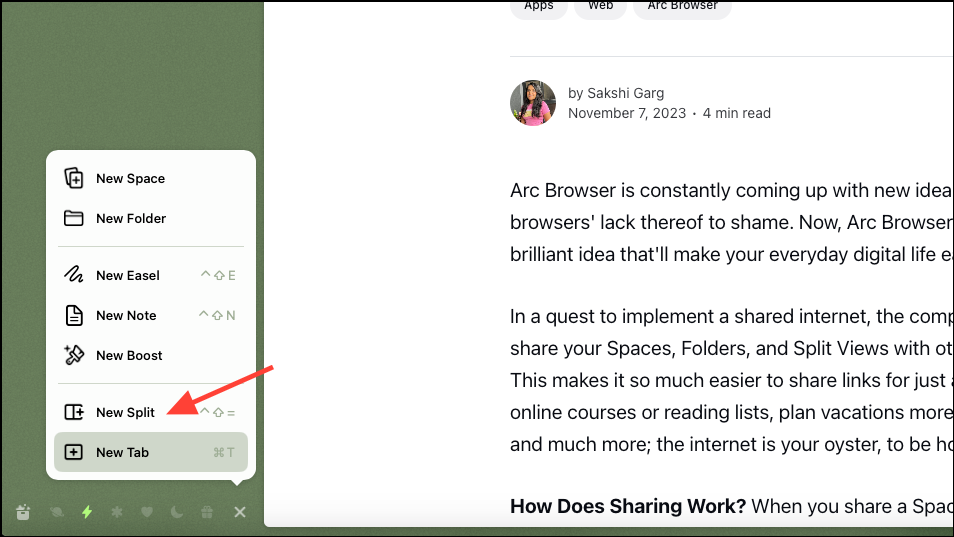
10. Extensions
Arc is built on the Chromium engine, so you also get support for extensions from the Chrome web store. You can simply go to the Chrome web store in the Arc browser and add any extension by clicking 'Add to Chrome'. This part is actually simple.
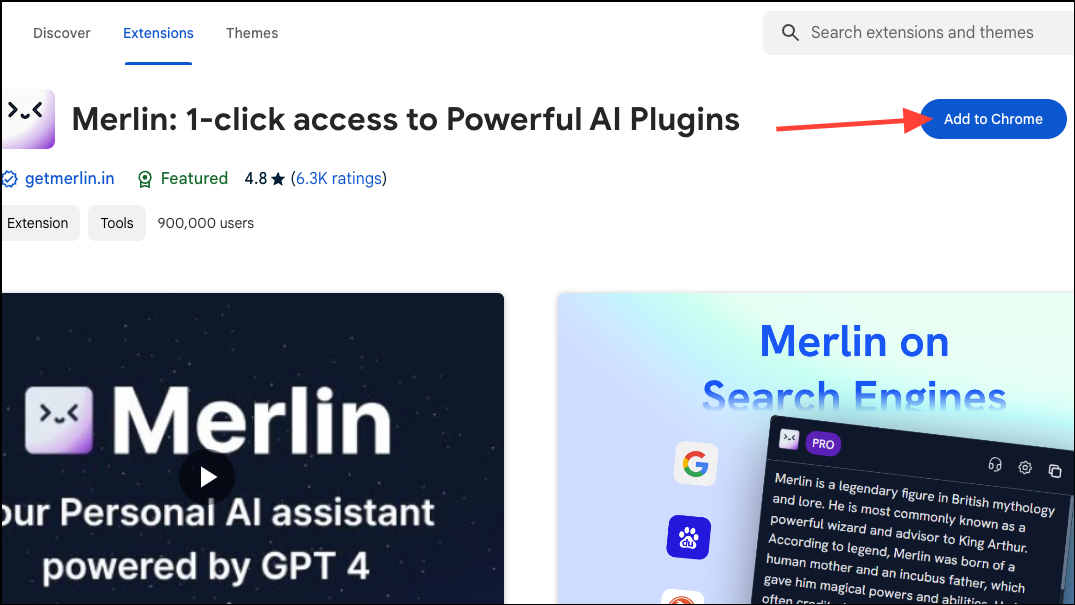
You can also import your extensions from your previous browser. We've discussed it at length in the guide below.

11. Library
In the bottom left corner of the sidebar, you'll find the icon to open the Library. You can also use the command bar to open it.

Library is where you can find your archived tabs, downloads, screenshots, Spaces, Boosts, and Easels, and notes. Boosts and Easels, and Notes are something else that give Arc an edge over the other browsers.

Notes are rather self-explanatory. You can open an empty page to jot down anything in the Arc Browser. These notes have a unique URL which means you can also share them with others. To create a new note, click '+' from the sidebar and select 'New Note'.
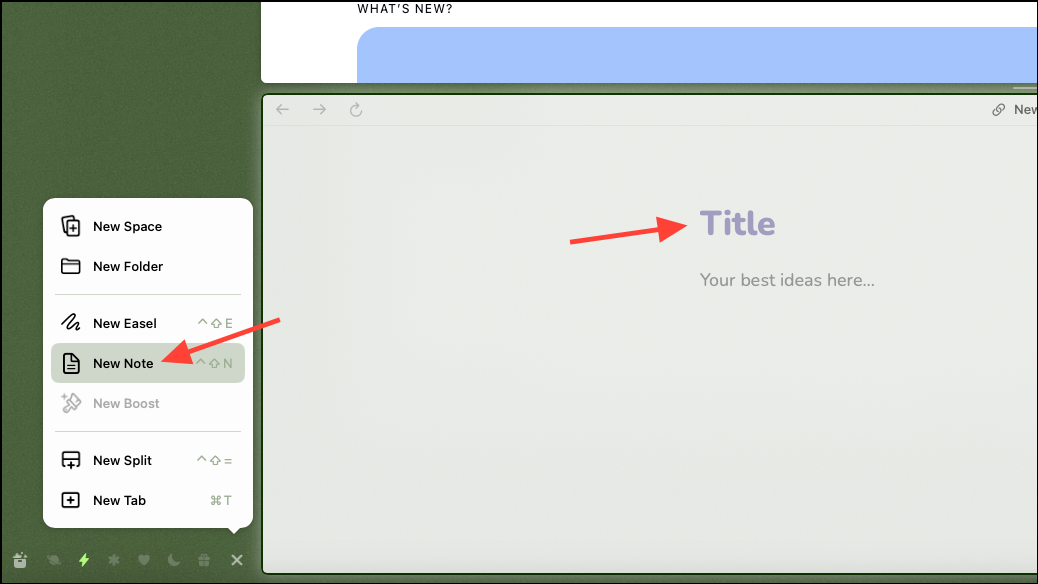
Easels are a whiteboard-like feature that's native to Arc. But unlike any other whiteboard, you can add live websites to an Easel. So, at any time, you could actually have a collection of different websites on a single page which you can check out at any time. To create an Easel, click '+' from the sidebar and select 'New Easel'.
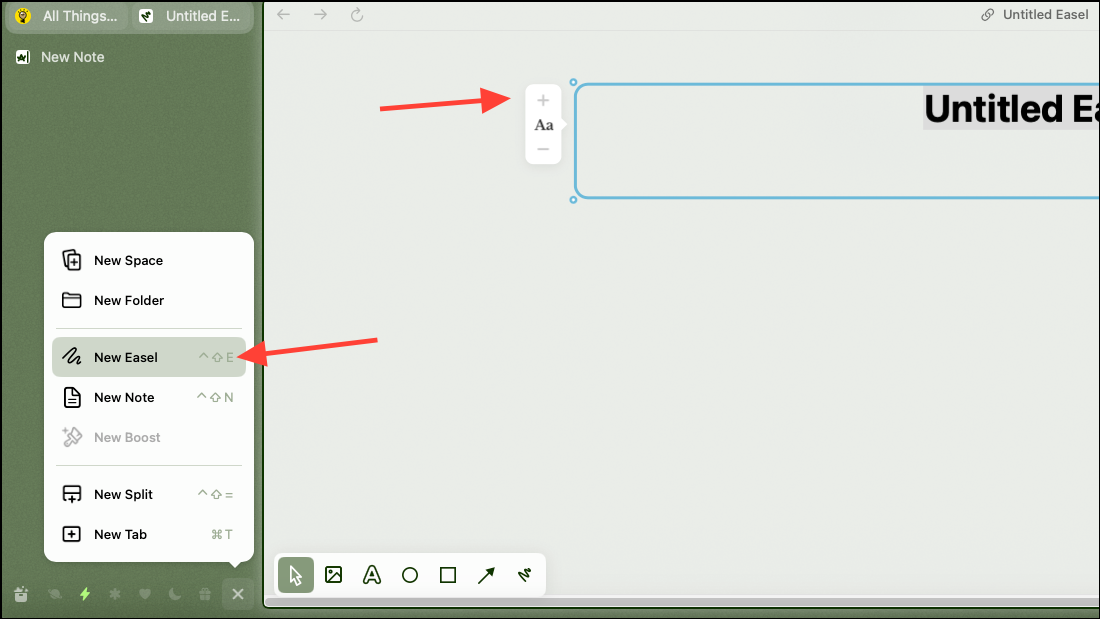
They're much broader to discuss in this guide, so you'll be better off hopping on to their dedicated guide linked below.

Boosts is another brainchild of The Browser Company that makes Arc different. With Boosts, you can change the appearance of any website and even share it with others. Boosts allow you to change the font, text size, colors, dark/ light theme, and much more, without any coding. It even lets you zap unwanted parts of a website, for example, Shorts on YouTube. You can also install Boosts shared by other Arc users. They definitely needed their separate guide which you should check out.

12. Media Controls and Picture-in-Picture
Another amazing feature of Arc is that it has built-in media controls and picture-in-picture that work with so many websites. For websites like Spotify, Arc Browser has a media controls toolbar that automatically appears on the sidebar whenever you leave the website. It's even available in other Spaces.

For websites like YouTube, Twitch, etc., the video is automatically minimized in Picture-in-Picture when you switch tabs. The PiP is even available in other apps, and other desktops on your Mac.
You can also move the window around and resize it. It also has basic controls for pausing/ playing the video, going back to the tab, and minimizing or closing the video altogether.
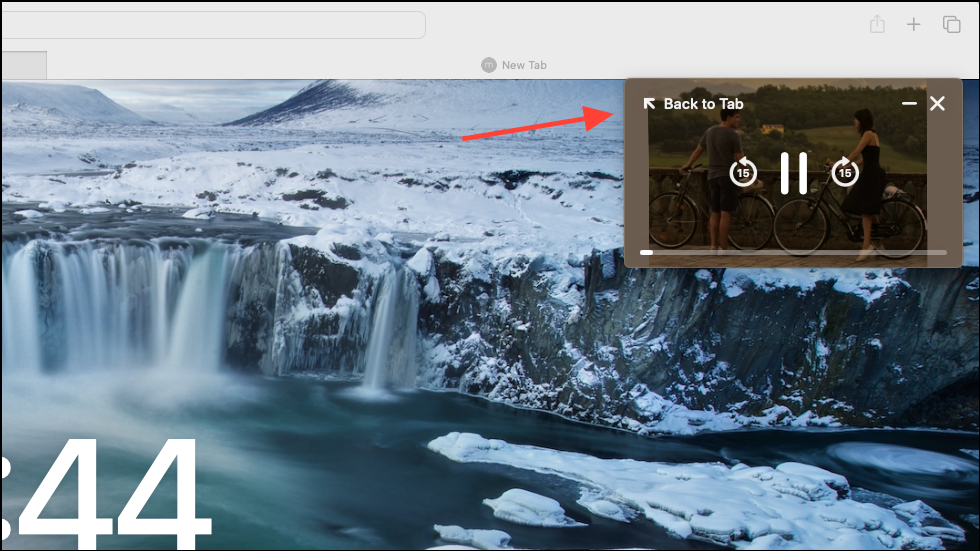
It also works with Google Meet, and the PiP window even has basic controls like turning off the microphone and camera, raising your hand, viewing chat, and disconnecting the call.

13. Arc Max
Arc has also incorporated a suite of AI features, known as Arc Max, to the browser. Under the umbrella of Arc Max, you get access to five features (currently for free of cost).
These include Ask ChatGPT in the Command Bar, Tidy Up Downloads, Tidy Page Titles, and 5-second page reviews/ summaries, and Ask on Page.
14. Multiple Windows
The only thing where Arc struggles with is multiple window management. Whenever you open a new window using Cmd + N, instead of opening a blank window, it opens a mirror copy of your current window, which can be rather frustrating. Any tabs you open or close in one window is mirrored in the other; what's really the point of that?
Arc also has a Little Arc feature, that allows you to open any link in a window independent of your main Arc window.

But Little Arc cannot accommodate more than one tab at a time. You can open a blank Arc window using the Ctrl + Cmd + N keyboard shortcut. Or, you can map the Cmd + N keyboard shortcut to open a new blank window, instead of a new window.
- To change Arc shortcuts, open the Settings window and switch to the 'Shortcuts' tab.
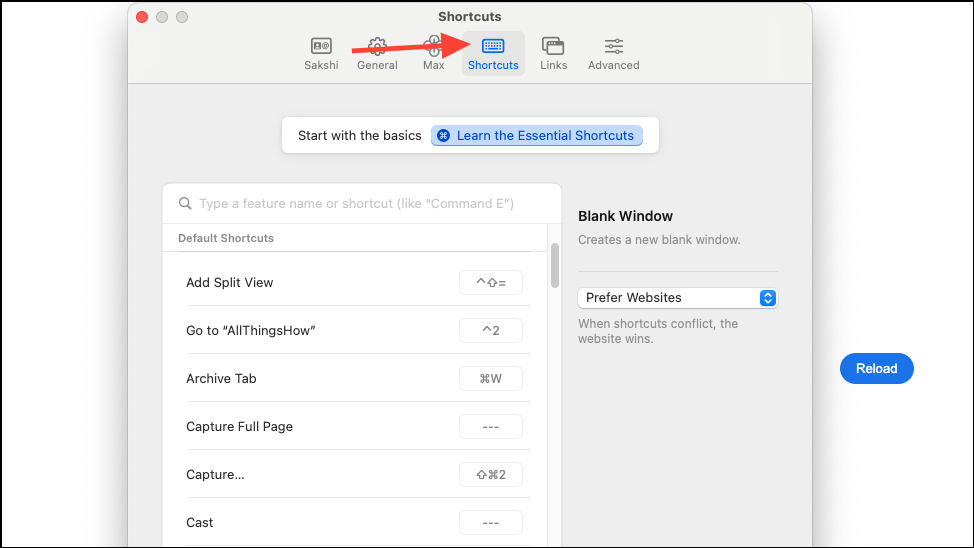
- Then, interchange the shortcuts for both 'New Blank Window' and 'New Window' by selecting them one by one and pressing the new shortcut keys for each.

The Arc browser offers a radically different browsing experience from other browsers through innovative features like Spaces, Boosts, Easels, built-in media controls, and PiP. While the learning curve is steep initially, mastering Arc's unique interface and shortcuts allows you to truly compartmentalize your digital life like never before. Overall, for users willing to adapt to its learning curve, Arc delivers a refreshing and powerful new way to browse the web from which you would not want to go back.


